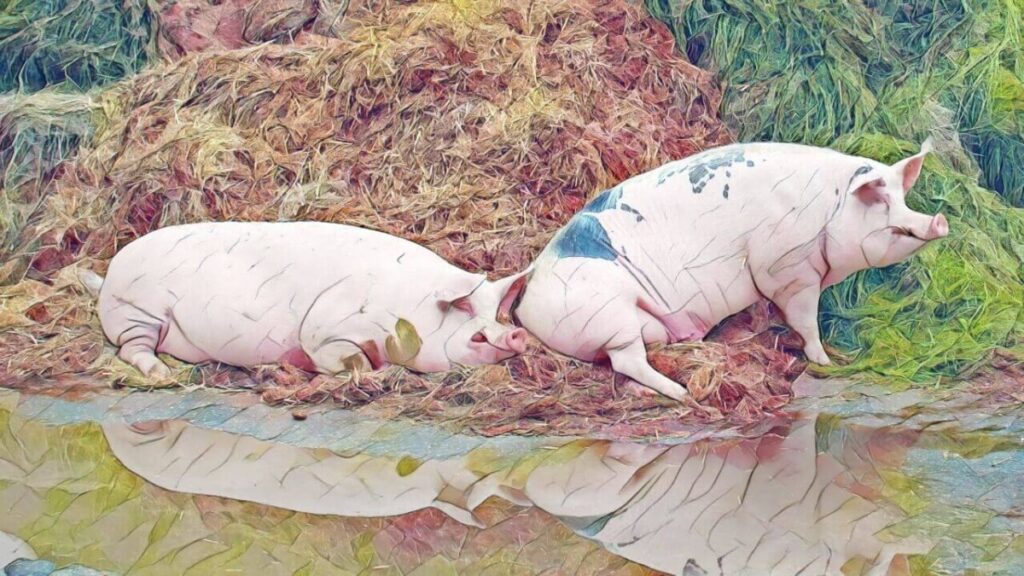Haematopinus suis (the pig lice) is another culprit of severe itchiness and scratching in pigs. These pesky parasites hide amongst the hairs on your pig’s skin. The louse is yellowish-brown and usually found in the fat folds around your pig’s neck, inside (and outside) their ears, legs, and flanks.
Each louse feeds off your pig and has mouth parts designed for piercing and sucking on the pig’s skin. Once the louse has fed, they develop a bluish coloring. In severe infestations, the lice can be found all over the body feeding on your pig, and the skin develops lesions from the continuous scratching and rubbing against fences, etc.
If you look closely at your pig’s skin, you’ll notice the eggs, which appear as yellow, crusty patches on the bristles of your pig’s hair. The eggs will hatch after 12 days, and the lice will be fully developed between 29 to 33 days.
Did you know: that the louse can also be a vector for the swine pox virus? So it’s vital to treat the infestation and avoid further infection.
Symptoms of Lice in Pigs
Your pig has lice if instead of biting at scratchy areas, it is restless and is continuously rubbing and scratching themselves against objects.Your pig will display other common symptoms, such as anemia, sudden weight loss, and depression.
Pay close attention to your pigs’ ears as the lice gather in the ears’ pinna to feed, which causes ulceration.
- Restlessness
- Depression
- Continuous scratching and rubbing against objects
- Anemia
- Weight loss
- Ulceration inside the pinna of the ears
- Allergy-like reactions from the lice
Treatment for Pig Lice
The only way to stop the itching is to treat and control the lice infestation urgently. This can be effectively done by applying lice treatment to your pig’s skin through injections, in their feed, or spray or pour-on solutions.
The treatment must be administered twice, within 10 to 14 days, to successfully kill off the lice, as the treatment is useless against the louse eggs. You can comb coconut oil through your pig’s bristles to remove dead lice and eggs.
- Apply lice treatment to your pig’s skin through injections, feed medications, and pour or spray on solutions.
- Two rounds of treatment must be given 10 to 14 days apart to kill off the lice, as treatments are ineffective against the louse eggs.
- Use coconut oil and comb through your pig’s hair and bristles to remove any dead lice and eggs. Dip the comb in hot water to remove the debris.
- Pay close attention to your pig’s ears (inside and out), as this is usually a hot spot for lice infestations.
References
Research Gate Published Article:
Mereks Vet Manual:
My Most Used Pig Supplies
This list contains affiliate products. Affiliate products do not cost more but helps to support BestFarmAnimals and our goal to provide farm animal owners with accurate and helpful information.
Purina Pig Chow will last well (or Mazuri is popular, but I haven’t tried it), and the stainless steel non-skid bowls that will help keep the mess down.
A pig blanket to keep her warm. This one also has bright colors and helps to provide rooting without the destruction.
Pig Harness for walking and handling your pig. There are a lot to choose from, but this one is pretty easy to use. If you want one that has a separate leash, this looks like a good one.
A large crate for keeping her safe in your house at night and when you leave the house. This is essential. You’ll also want a litterbox, and I like mine with a lid for nighttime. Pine shavings are best, and you may be able to find them in larger quantities locally.
When you have accidents, Odoban will help eliminate odors. When you are potty training, these floor pads work great for keeping your house clean while training her to go in certain places.
You’ll also want an outdoor house to keep her warm when she gets outside time, an essential part of her development.
Dewormer- Ivermectin is the primary dewormer I use, although I do rotate with a non-ivermect ingredient once so that the worms don’t get immune to it.

